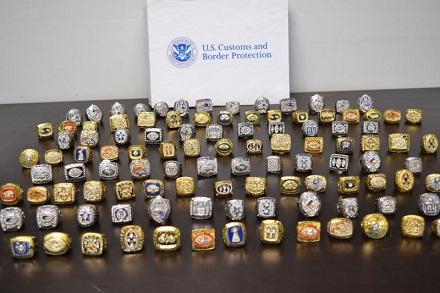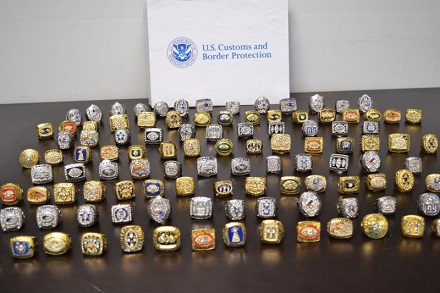

In 2018, according to The Washington Examiner, federal agents in the U.S. Immigration and Customs Enforcement's Homeland Security Investigations (HSI) branch seized approximately $20 million in counterfeit items that would have been sold for the Super Bowl. Operation Team Player, an annual project to confiscate fake merchandise and identify fraudulent dealers, netted 260,000 counterfeit sports-related items, and led to the arrests of 56 people. (In 2017, 450,000 items were collected, worth approximately $39 million.)
The industry of black-market goods is fed by Internet sales, which thrive by offering cut rates for unlicensed products coming out of China, and by dealers stateside, who buy such products in bulk and then sell them near the stadium in the days leading up to the game.
Or, say officials, they may have the facilities to create their own apparel and other goods and try to pass them off as the genuine article. At best, consumers get shoddy merchandise that falls apart. At worst, they purchase tickets for the Super Bowl and find out they’re fakes – when they arrive at the gate.
Another setback for the defense is that, at least when it comes to apparel, the public doesn’t seem to care about the problem of counterfeiting. In fact, their take is often to feel victimized by the fact that “the dealers with the good prices” were put out of business. As a result, agencies fight the battle on two fronts: trying to squelch the counterfeiters themselves and trying to educate the buyers who propagate illegal activity.
And here, DHS assistant special agent Richard Halverson told the Chicago Tribune, many shoppers are mistaken in thinking the only ones who lose out are the pro leagues. International crime rings use counterfeiting operations to launder money from illegal drug sales and human trafficking. "This is not a victimless crime," Halverson says.
Drilling down to the local level, black-market goods actually hurt host cities of major events, according to Promo Marketing.
"Criminal elements use major sporting events like the Super Bowl as an opportunity to sell substandard and counterfeit goods to the American public," Acting ICE Director Thomas D. Homan told the Washington Examiner. "ICE special agents are committed to collaborating with industry and law-enforcement agencies to crackdown on counterfeiting that significantly impacts local economies and funnels money into organizations involved in additional illicit activities."
Almost without exception, the public hears about the problems of counterfeit merchandise when federal agencies, in cooperation with pro sports teams, do what journalists call ‘show-and-tells’ of confiscated merchandise, much of which comes from stings timed to major events such as the World Series, Super Bowl and Stanley Cup.
The fight goes on, however, all year long. (Fun fact: In mid-2018, Customs and Border Patrol officers seized a shipment of 108 bogus Super Bowl rings. A real Super Bowl ring costs upwards of $10,000. The ones confiscated by agents cost $25 each.)
A report from The Oregonian noted that as far back as 2012, the major professional sports leagues in the U.S. had lost over $13 billion in revenue due to sales of counterfeit jerseys and apparel. The NFL had the most the most losses to counterfeits that year, with nearly $3 billion of the total, according to The Licensing Letter.
Officials have continued to widen the net, arresting dealers who routinely set up shop at regional flea markets, selling counterfeit logo merchandise to consumers. Law enforcement officials have also shut down dozens of websites selling knockoff NFL jerseys and more. And those who attempt to steal a team’s thunder by trying to create their own trademark quickly find out it doesn’t work out very well.
Back in 2015, SDM posed the question: Why should sports planners, particularly those planning youth or amateur events, care about counterfeiting? And the answer – well, there were a number of them:
It takes money away from legitimate vendors, including you: Picture this. You have paid to have a logo designed for your youth sports event. You’ve made sure that logo appears on your website, any printed materials and on all your social media. And you plan to give all participants a logo T-shirt – and make more available for sale to parents, family members and friends who traveled in. So not only is there a cool souvenir, but the potential for income as well.
Except when you arrive at the venue, there are already people wearing your T-shirts. Turns out, someone downloaded the image off the Internet and went to an online retailer who made shirts with your design on them. Oh, and they’ve sold them to a lot of the people coming in the gate. And suddenly, you have boxes of shirts that nobody seems to want because they already bought one, thanks, and for less than what you’re charging.
That’s counterfeiting. That’s what it does to sports events.
It creates and perpetuates a marketplace of inferior and unsafe products: Looking beyond souvenir jerseys, hats and T-shirts for a moment, it’s easy to see why counterfeiting is such a threat to the sports market. Players depend on good equipment for optimal performance. But good equipment can be an investment (particularly for youth players who grow out of it quickly) so it’s not uncommon for parents, coaches and others to shop around on the Internet, trying to find a better deal on a piece of equipment, whether that’s a tennis racquet, a football helmet or anything else. And some of the top places to hunt for bargains are online auction sites such as eBay and marketplaces like Amazon – both of which have been called on the carpet for hosting illegal sellers.
And while a counterfeit racquet can break, or give a wicked case of tennis elbow, there is more serious potential for harm in a knockoff youth sports helmet or other protective gear.
See why it’s so important? And here are a few other reasons sports planners should care:
It hurts American manufacturing: Less than five years ago, United States-based cap maker New Era reported losing $300 million a year in sales to foreign companies selling counterfeit baseball caps, according to Buffalo Business First. And in 2019, reeling from even more losses, New Era was forced to shut down its production plant in Derby, New York, leaving more than 300 workers without jobs.
Sadly, it’s not a unique situation. In fact, an article in SportsOne Source noted that buying counterfeit products has a significant impact on the global economy, eliminating tens of thousands of jobs with legitimate businesses and costing the economy an estimated $600 billion of revenue a year.
It hurts workers: Counterfeiters who operate out of places like China are not accountable to human rights and environmental regulations nor do they adhere to child labor laws, anti-sweatshop laws, or restricted substances laws. This puts workers, the environment and consumers at risk.
It’s a crime. Really. The website, StopFakes.gov, lists more than a dozen agencies, including Immigration and Customs Enforcement (ICE) and U.S. Homeland Security Investigations, all of whom have jurisdiction over different aspects of the problem. In fact, Customs and Border Patrol (CBP), another agency involved, has an e-allegation portal through which people can anonymously provide information on suspected counterfeiting.
Event owners and DMOs can help: Sourcing merchandise from reputable domestic vendors is a simple step toward cleaning up the industry. It’s also possible to look for problems-in-the-making by keeping an eye on sales that might be going on prior to, during or after their event, by unauthorized individuals, and by reporting those. In addition, it’s possible to help raise awareness of the dangers of counterfeit equipment among athletes.
Nobody is alone in the fight: A number of trade associations serving the sports industry have made it their business to provide reporting mechanisms for players and others who know about counterfeit merchandise. The Tennis Industry Association (TIA), for example, provides a portal through which suspicious activity can be reported.
Meanwhile, you’ll find the NFL cracking down on any black-market goods (and the sellers trying to pass them off as the real thing).
“Is it aggressive? Yes,” Joseph Wargo, an intellectual property attorney at the firm Wargo & French, said in an interview with the Atlanta Constitution-Journal last year. “This isn’t the NFL’s first rodeo.”

